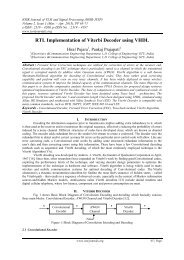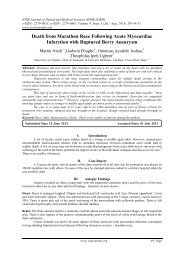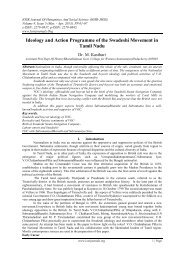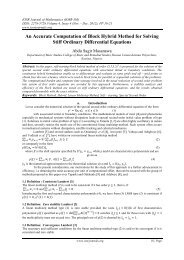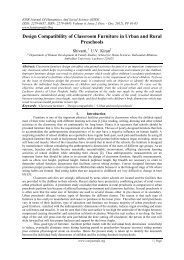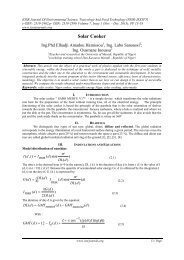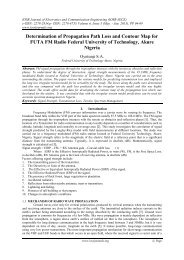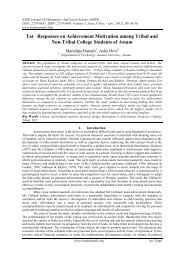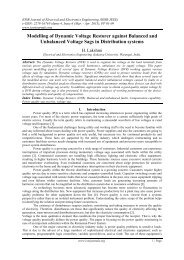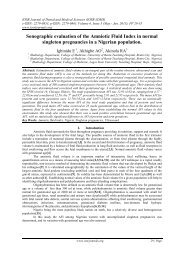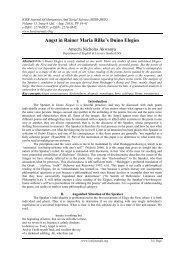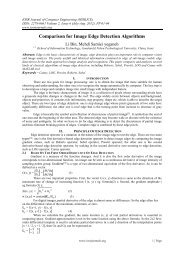Initial Conquest of India by Turks and Their Slaves - IOSR
Initial Conquest of India by Turks and Their Slaves - IOSR
Initial Conquest of India by Turks and Their Slaves - IOSR
Create successful ePaper yourself
Turn your PDF publications into a flip-book with our unique Google optimized e-Paper software.
<strong>Initial</strong> <strong>Conquest</strong> Of <strong>India</strong> By <strong>Turks</strong> And <strong>Their</strong> <strong>Slaves</strong><br />
kind dated V.S. 1220/1163A.D record his extermination <strong>of</strong> the malecchas <strong>and</strong> restoration <strong>of</strong> the country to the<br />
Aryas.A more definite evidence <strong>of</strong> the threatening advance <strong>of</strong> the <strong>Turks</strong> is furnished <strong>by</strong> an inscription <strong>of</strong><br />
Prithviraja I recording the fortification <strong>of</strong> the frontier town <strong>of</strong> Hansi to check the progress <strong>of</strong> “the Hammira who<br />
has become the cause <strong>of</strong> anxiety to the world. The mention <strong>of</strong> Hansi along the Pakpattan indicates the tract<br />
through which the Turkish attacks were being delivered. Subsequently, at a date which is variously given as<br />
583/1187-8 or 587-1191 Muizz-ud-Din invaded eastern Punjab <strong>and</strong> established a garrison at Tabarhindh<br />
(Bhatinda), situated about a hundred miles north <strong>of</strong> Hansi. He left Ziauddin <strong>of</strong> Tulak with 12,000 troops to hold<br />
it till his return. But Prithviraja in person <strong>and</strong> his subordinate Govindraja <strong>of</strong> Delhi recovered the fortress. In the<br />
battle fought near the village <strong>of</strong> Tarain, not far from the fort. In this battle Muizz-ud-din was decisively beaten.<br />
Prithviraj immediately invested the fortress but it took him thirteen months to force Ziauddin to surrender.<br />
Muizz-ud-din returned in 588/1192 <strong>and</strong> once more met his chauhana adversary on the field <strong>of</strong> Tarain. He<br />
divided his forces into five divisions, four <strong>of</strong> which engaged the enemy on all sides. At the end <strong>of</strong> the day the<br />
fifth division, kept in reserve, attacked the exhausted enemy <strong>and</strong> thus decided the issue, Kh<strong>and</strong>i Rai (Govinda<br />
Rai) was killed <strong>and</strong> Prithviraja trying to escape, was captured near Sarsuti. <strong>and</strong> at Ajmer he was put to death.<br />
This victory laid the whole Chauhana kingdom at Muiz-ud-din's feet Hansi, Kuhram <strong>and</strong> Sarsuti, all places <strong>of</strong><br />
military importance, were immediately occupied <strong>and</strong> garrisoned. This victory at Tarain also seems to have<br />
constituted a turning point in two respects. Firstly, the Hindu chiefs <strong>of</strong> the eastern Punjab undertook to pay<br />
tribute to Muizz-ud-din. And in the second place, it is from this moment that we can date the establishment <strong>of</strong> a<br />
permanent Muslim force in the region, at Indraprashta (Indrapat), near Delhi. But not on uniform basis. At<br />
Inderpat near Delhi an occupation army was stationed under the comm<strong>and</strong> <strong>of</strong> Qutubuddin Aibak who was to act<br />
as Muizz-ud-din's representative in <strong>India</strong>. The conqueror then returned to his central Asian projects (leaving<br />
Aibak with wide powers to consolidate <strong>and</strong> extend the conquests) where from he returned to <strong>India</strong> for each cold<br />
season to take charge <strong>of</strong> the war against the infidel.<br />
In Ramzan 588/1192 Aibak defeated <strong>and</strong> slain a Hindu chief whom Hasan Nizami calls Jatwan in<br />
Bagar. He then crossed the Jumna to establish a military base in upper Doab. The greater part <strong>of</strong> the region was<br />
held, under the Gahadavalas, <strong>by</strong> Dor Rajputs with their strong hold at Baran. By treachery the Baran was<br />
captured. Meerut was also occupied <strong>and</strong> both the places were garrisoned <strong>and</strong> fortified <strong>and</strong> they became the<br />
spearheads <strong>of</strong> attack from the north on the Gahadvala dominions. The camp at Inderpat was clearly a temporary<br />
residence <strong>and</strong> could hardly satisfy the growing needs <strong>of</strong> a political capital. Ajmer situated well inside Rajputana,<br />
appeared unsuitable. Delhi was a better alternative, its situation <strong>and</strong> historical traditions provided the necessary<br />
features. In 589/1193 Aibak moved his forces against the Tomara ruler <strong>of</strong> city <strong>and</strong> occupied it with comparative<br />
ease. Delhi thus became the capital <strong>of</strong> Muizz-ud-din's <strong>India</strong>n dominion. Aibak was busy in suppressing the<br />
Harriraja, the brother <strong>of</strong> late Chauhana king who besieged Ranthambhor <strong>and</strong> with dispossessed ruler <strong>of</strong> Delhi<br />
when according to Hasan Nizami, Aibak was sent to Ghazni <strong>by</strong> his master where he stayed for six months <strong>and</strong><br />
on his return in 590/1194, Aibak crossed the Jumna a second time <strong>and</strong> captured Kol (Koil, Aligarh). Muizz-uddin<br />
assisted <strong>by</strong> the Aibak invaded Banaras, Whose ruler Jayach<strong>and</strong>ra met them in the vicinity <strong>of</strong> Ch<strong>and</strong>war on<br />
the Jumna, between Kanouj <strong>and</strong> Etah. Jayach<strong>and</strong>ra was defeated <strong>and</strong> killed in this battle. This victory added<br />
another great Kindgdom as far as Monghyr to the Shansabani empire. Malik Husamuddin Ughulbak became its<br />
first comm<strong>and</strong>ant (Muqti). Next year in 592/1195-6. Muizz-ud-din again came to <strong>India</strong> <strong>and</strong> moved against<br />
Bayana, the capital <strong>of</strong> the Jadon Bhatti Rajputs. Without any difficulty the city was conquered as the ruler do not<br />
give resistance. Then Thangir (Tahangarh) <strong>and</strong> fortified Vijayaym<strong>and</strong>irgarh were occupied <strong>and</strong> garrisoned under<br />
Bahauddin tughril. After that Muizz-ud-din captured the strong fort <strong>of</strong> Gwalior, held <strong>by</strong> the Parihara prince<br />
named Sallakshanapala, <strong>by</strong> Hasan Nizami.<br />
In 592/1196 Aibak re-occupied Ajmer, thwarting an attempt <strong>by</strong> the tribal Mhers, in alliance with the<br />
dispossessed chauhans <strong>and</strong> Chalukyas, to retake it. In 1197, Aibak plundered Nahrwala (Anhilwara) in Gujarat,<br />
although the province was not subdued. In 594/1197-8, Badaun was captured followed <strong>by</strong> the second occupation<br />
<strong>of</strong> Banaras. Next year in 595/1198-9, “Chantarwal (Ch<strong>and</strong>war) <strong>and</strong> Kanauj were captured. The opening <strong>of</strong> the<br />
Thirteenth century saw the Turkish forces engaged against the last surviving imperial Rajputs <strong>of</strong> Bundelkh<strong>and</strong><br />
(Jejakabhukti) <strong>and</strong> in 599/1202 <strong>Turks</strong> attacked Kalinjar the military capital <strong>of</strong> Paramardideva <strong>and</strong> conquered it<br />
<strong>and</strong> also its principal forts Mahoba <strong>and</strong> Khajuraho were then occupied <strong>and</strong> grouped into a military division<br />
under the comm<strong>and</strong> <strong>of</strong> Hasan Arnal. Badaun appears to have been the starting point for further conquests, first<br />
in Awadh, <strong>and</strong> then in Bihar <strong>and</strong> Bengal, undertaken <strong>by</strong> Muhammad bin Bakhtiyar (Ikhtiyaruddin) Muhammad<br />
Bakhtiyar. A Khaliji troop under the Malik Husammuddin Ughulbak, the comm<strong>and</strong>er <strong>of</strong> Banaras <strong>and</strong> Awadh<br />
division. Proceeding into Magadha, region east <strong>of</strong> the Karamanasa river he initiated raids into Maner <strong>and</strong> Bihar<br />
<strong>and</strong> obtained ample resources. Bakhtiyar obtained Aibak‟s commendation for a final attack on the monastery<br />
town which must have been Udd<strong>and</strong>apura Juzjani describes the whole <strong>of</strong> this fortress <strong>and</strong> city as a vihara, which<br />
he explains, is a madrasa‟ or „place <strong>of</strong> learning in the Hindwi Language‟ inhabited largely <strong>by</strong> Shaven-headed<br />
brahmans‟, that is <strong>by</strong> Buddhist monks, which were all slain. Tibetan author <strong>of</strong> the early seventeenth century,<br />
Tarantha, in his „History <strong>of</strong> Buddhism in <strong>India</strong>‟, writes that the Stag-gzigs‟, „<strong>Turks</strong>‟ „overran the whole <strong>of</strong><br />
www.iosrjournals.org<br />
5 | Page



